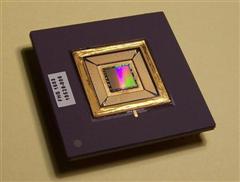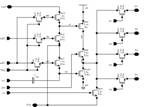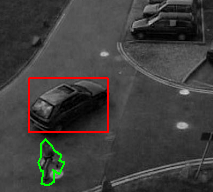 Vision
chips are microelectronic devices, which combine image sensing and
processing on a single silicon die. In a way somewhat resembling the
vertebrate retina, these semiconductor chips perform preliminary image
processing directly on the sensory plane. They can be used for computer vision
applications in areas such as autonomous vehicle guidance, robotics,
industrial inspection or surveillance. We investigate the
design of vision chips, using CMOS technologies. Integrating a
processing element (PE) within each pixel of the image sensor array results in
thousands of processors working concurrently, which enables the processing
speeds of billions of operations per second to be easily achieved,
at very low power consumption. Vision
chips are microelectronic devices, which combine image sensing and
processing on a single silicon die. In a way somewhat resembling the
vertebrate retina, these semiconductor chips perform preliminary image
processing directly on the sensory plane. They can be used for computer vision
applications in areas such as autonomous vehicle guidance, robotics,
industrial inspection or surveillance. We investigate the
design of vision chips, using CMOS technologies. Integrating a
processing element (PE) within each pixel of the image sensor array results in
thousands of processors working concurrently, which enables the processing
speeds of billions of operations per second to be easily achieved,
at very low power consumption.
|
 Cellular processors arrays offer high computing performance and are ideally
suited to perform pixel-parallel image processing tasks. Our research focuses
on computer architectures based on fine-grain SIMD processor arrays and asynchronous
cellular automata. We have developed several approaches, e.g. SCAMP is family
of mixed-mode pixel-per-processor SIMD array devices while ASPA devices are
massively parallel processor
arrays which work in asynchronous/synchronous mode running wave-propagating
algorithms. We implement integrated circuits in state-of the-art and emerging
silicon technologies, such as sub-100nm CMOS and stacked 3D wafers. Cellular processors arrays offer high computing performance and are ideally
suited to perform pixel-parallel image processing tasks. Our research focuses
on computer architectures based on fine-grain SIMD processor arrays and asynchronous
cellular automata. We have developed several approaches, e.g. SCAMP is family
of mixed-mode pixel-per-processor SIMD array devices while ASPA devices are
massively parallel processor
arrays which work in asynchronous/synchronous mode running wave-propagating
algorithms. We implement integrated circuits in state-of the-art and emerging
silicon technologies, such as sub-100nm CMOS and stacked 3D wafers.
|
 Brain-inspired
VLSI circuits may one day replace conventional microprocessors as more
robust and intelligent systems. They will be also used as controllers for
autonomous robots, and in prosthetic devices. We research digital FPGA based,
and analogue full-custom VLSI based acceleration engines for neural
computation. Currently we participate in two
collaborative projects, REVERB and COLAMN, supported under the EPSRC Novel
Computation Initiative, where we work with neuroscientists,
psychologists and computer scientists, investigating computation in biological
neural networks and designing neuromorphic chips and systems implementing
natural computation in hardware. Brain-inspired
VLSI circuits may one day replace conventional microprocessors as more
robust and intelligent systems. They will be also used as controllers for
autonomous robots, and in prosthetic devices. We research digital FPGA based,
and analogue full-custom VLSI based acceleration engines for neural
computation. Currently we participate in two
collaborative projects, REVERB and COLAMN, supported under the EPSRC Novel
Computation Initiative, where we work with neuroscientists,
psychologists and computer scientists, investigating computation in biological
neural networks and designing neuromorphic chips and systems implementing
natural computation in hardware.
|
 Analogue
signal processing circuits can offer higher efficiency (in terms of
performance, silicon area and power dissipation) than their digital
counterparts. We investigate algorithmically programmable general-purpose
analogue microprocessors build using switched-current circuit techniques
and analogue implementations of spiking neural networks. We are interested in
ultra-low power computing hardware. We are also developing sensors, sensor
interface circuits and signal processing circuits
for biomedical applications, such as high-frequency medical ultrasound
systems. Analogue
signal processing circuits can offer higher efficiency (in terms of
performance, silicon area and power dissipation) than their digital
counterparts. We investigate algorithmically programmable general-purpose
analogue microprocessors build using switched-current circuit techniques
and analogue implementations of spiking neural networks. We are interested in
ultra-low power computing hardware. We are also developing sensors, sensor
interface circuits and signal processing circuits
for biomedical applications, such as high-frequency medical ultrasound
systems.
|
 Novel
algorithms need to be developed to take full advantage of the massively
parallel hardware. We investigate ways of efficiently mapping low- and
mid-level image processing algorithms onto processor arrays. We are interested
in computer vision and machine intelligence, especially in the context of
autonomous robots. We work on brain-inspired algorithms for object recognition
and efficient simulation of large biologically plausible neural network models
using a range of techniques including processing using GPUs and other parallel
hardware as well as custom processors. We are also
developing systems and software tools for controlling and programming
fine-grain processor arrays and vision chips Novel
algorithms need to be developed to take full advantage of the massively
parallel hardware. We investigate ways of efficiently mapping low- and
mid-level image processing algorithms onto processor arrays. We are interested
in computer vision and machine intelligence, especially in the context of
autonomous robots. We work on brain-inspired algorithms for object recognition
and efficient simulation of large biologically plausible neural network models
using a range of techniques including processing using GPUs and other parallel
hardware as well as custom processors. We are also
developing systems and software tools for controlling and programming
fine-grain processor arrays and vision chips
|

 Vision
chips are microelectronic devices, which combine image sensing and
processing on a single silicon die. In a way somewhat resembling the
vertebrate retina, these semiconductor chips perform preliminary image
processing directly on the sensory plane. They can be used for computer vision
applications in areas such as autonomous vehicle guidance, robotics,
industrial inspection or surveillance.
Vision
chips are microelectronic devices, which combine image sensing and
processing on a single silicon die. In a way somewhat resembling the
vertebrate retina, these semiconductor chips perform preliminary image
processing directly on the sensory plane. They can be used for computer vision
applications in areas such as autonomous vehicle guidance, robotics,
industrial inspection or surveillance.  Cellular processors arrays offer high computing performance and are ideally
suited to perform pixel-parallel image processing tasks. Our research focuses
on computer architectures based on fine-grain SIMD processor arrays and asynchronous
cellular automata. We have developed several approaches, e.g. SCAMP is family
of mixed-mode pixel-per-processor SIMD array devices while ASPA devices are
massively parallel processor
arrays which work in asynchronous/synchronous mode running wave-propagating
algorithms. We implement integrated circuits in state-of the-art and emerging
silicon technologies, such as sub-100nm CMOS and stacked 3D wafers
Cellular processors arrays offer high computing performance and are ideally
suited to perform pixel-parallel image processing tasks. Our research focuses
on computer architectures based on fine-grain SIMD processor arrays and asynchronous
cellular automata. We have developed several approaches, e.g. SCAMP is family
of mixed-mode pixel-per-processor SIMD array devices while ASPA devices are
massively parallel processor
arrays which work in asynchronous/synchronous mode running wave-propagating
algorithms. We implement integrated circuits in state-of the-art and emerging
silicon technologies, such as sub-100nm CMOS and stacked 3D wafers Brain-inspired
VLSI circuits may one day replace conventional microprocessors as more
robust and intelligent systems. They will be also used as controllers for
autonomous robots, and in prosthetic devices. We research digital FPGA based,
and analogue full-custom VLSI based acceleration engines for neural
computation.
Brain-inspired
VLSI circuits may one day replace conventional microprocessors as more
robust and intelligent systems. They will be also used as controllers for
autonomous robots, and in prosthetic devices. We research digital FPGA based,
and analogue full-custom VLSI based acceleration engines for neural
computation.  Analogue
signal processing circuits can offer higher efficiency (in terms of
performance, silicon area and power dissipation) than their digital
counterparts. We investigate algorithmically programmable general-purpose
analogue microprocessors build using switched-current circuit techniques
Analogue
signal processing circuits can offer higher efficiency (in terms of
performance, silicon area and power dissipation) than their digital
counterparts. We investigate algorithmically programmable general-purpose
analogue microprocessors build using switched-current circuit techniques Novel
algorithms need to be developed to take full advantage of the massively
parallel hardware. We investigate ways of efficiently mapping low- and
mid-level image processing algorithms onto processor arrays. We are interested
in computer vision and machine intelligence, especially in the context of
autonomous robots. We work on brain-inspired algorithms for object recognition
and efficient simulation of large biologically plausible neural network models
using a range of techniques including processing using GPUs and other parallel
hardware as well as custom processors.
Novel
algorithms need to be developed to take full advantage of the massively
parallel hardware. We investigate ways of efficiently mapping low- and
mid-level image processing algorithms onto processor arrays. We are interested
in computer vision and machine intelligence, especially in the context of
autonomous robots. We work on brain-inspired algorithms for object recognition
and efficient simulation of large biologically plausible neural network models
using a range of techniques including processing using GPUs and other parallel
hardware as well as custom processors.